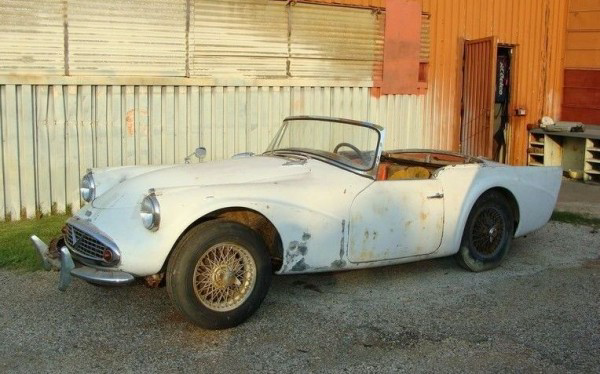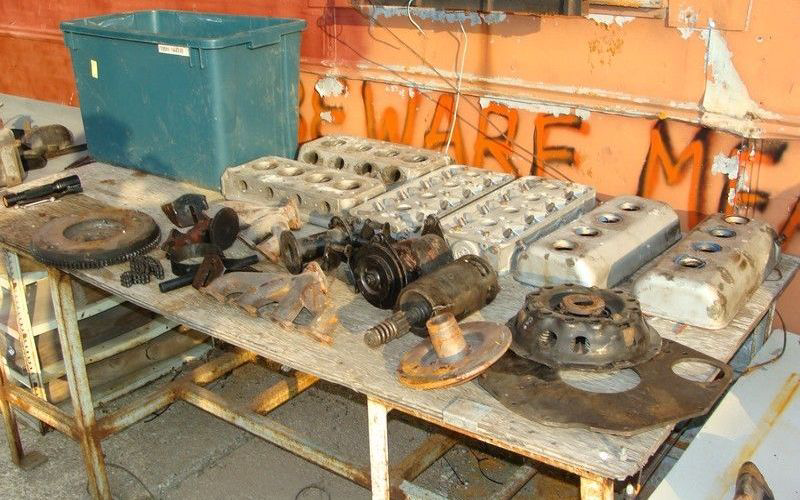Fish Face: 1962 Daimler SP250
It may be an acquired taste, but I actually the looks of the Daimler SP250. Its awkward curves and fish-mouth grill make it stand out amongst a crowd of more aesthetically pleasing machines. I would love to have one, but current values and limited supply keep them just out of reach. This could be the chance to get into one on the cheap. Just don’t expect it to stay that way. Find this project here on eBay in Dallas, Texas with bidding is currently at $4,650.
As mentioned, this project is going to get expensive. Luckily, some of the parts came from other cars so that should help a bit. The frame, for example, was sourced from a Triumph TR3. The early cars exhibited a lot of flex, but by the time this one was built the factory had started welded in some additional bracing. It’s not going to make much difference here though with all that rust. The body on frame design should make repairs easier though and if necessary the whole frame could be replaced.
Unfortunately, one of the previous owners pulled the engine out and disassemble it. The block is in the trunk and the internals are displayed here on a table. Notice those alloy heads. Many people think of Chrysler when they hear hemi, but quite a few engines have been fitted with hemispherical cylinder heads over the years. Chrysler was just the one who really marketed the idea as being something special. The small V8 in this car was capable of about 140 horsepower when new.
There isn’t much to the interior, so hopefully a good upholstery shop can put something together. There might even be enough of the passenger’s side seat left to create a pattern for new covers. The dash and gauges don’t look too bad and the bows for the top are still in place. Jaguar had purchased Daimler by this time, so perhaps there are even some bits from their parts bin in here?
Understandably, this sports car isn’t for everyone. It has limited parts supply, mediocre performance, and a face only a mother could love. Still the Daimler “Dart” is something special that you don’t see everyday. Only a little over 2,600 were ever built and it is doubtful that very many of those are still around. Values may be going up, but even #4 cars have sold for under $20k so there isn’t much room left for this to go up and still be a good buy. So, I hope that the seller has set a realistic reserve and that someone steps up to save this fish face.
Auctions Ending Soon
 2006 Ford Mustang Saleen S281 SCBid Now6 hours$16,000
2006 Ford Mustang Saleen S281 SCBid Now6 hours$16,000
 2002 Subaru Impreza WRXBid Now3 days$333
2002 Subaru Impreza WRXBid Now3 days$333
 1975 Chevrolet Corvette ConvertibleBid Now3 days$3,000
1975 Chevrolet Corvette ConvertibleBid Now3 days$3,000
 1964 Ford F-100 Camper CustomBid Now3 days$2,000
1964 Ford F-100 Camper CustomBid Now3 days$2,000
 2006 Jeep Wrangler SportBid Now5 days$10,500
2006 Jeep Wrangler SportBid Now5 days$10,500






Comments
The front view is actually pretty nice, its’ just that profile view that makes one wonder what the designer was thinking about. A favorite fishing hole perhaps?
It looks kind of like a shrunk down roadster version of the Packard Hawk I’m currently restoring.
Exactly my thought. The front end treatment looks like an afterthought. In the Packard Hawk, it was added to a Studebaker. Somehow, it seems to work with the Packard, but the 250 is even uglier in person than it is in pics.
you guys have a thing for these, i think. i see a lot of rust in the frame, a strap holding up the drive shaft because there is no diff, and tape holding the hood shut. this is going to take a lot of time/money. might be fun. nice find
Looks like the restorer kept taking things apart….and apart some more….until…..
“Gosh, this is going to need a lof of new parts, and it’s going to be tough to put it back together right. Think I’ll just sell it and let somebody else figure it out. I wonder if there’s any cold beer in the fridge.”
Slightly off topic. If the ” hemi ” concept is so great , why are just about all engines not manufactured in this way . To my knowledge , it is merely the shape of the combustion chamber that makes the diff. but is more expensive to manufacture ??
Henrie.
it’s more to do with the alignment of the valves. With the “hemi” design the inlet and exhaust valves need to be aligned in very different planes. With a traditional “bathtub” or “wedge’ head design the inlet and exhaust valves can all be aligned in one plane – which makes operating them by push-rod much easier and quite compact. if you look at the Chrysler hemi head you’ll see how convoluted the rocker configuration had to be to work the valves off a single camshaft with push-rods.
As the description above says, Chrysler were certainly not the first to use the hemi head idea. many other engiens used it, including the Triumph Speed-twin motorcyle engine from 1938 designed by Edward Turner, who also designed the Daimler engine in this car. The Triumph motorcyle engine, although it was a low camshaft, push-rod design, used two camshafts, on infront of the block and one behind, so that there was no issue operating the valves.
DOHC configuration makes it much easier to operpate the valves in a hemi head, as per Jaguar’s XK series engines (and many other like the Ason Martin DOHC sixes).
Jesse, sure is an acquired taste and not one acquired by me. I blogged about it on July 8th, showing what beautiful cars Daimler had produced in the past. I wondered if the SP250 designer had a grudge against management when he penned this monstrosity?
Barry thomas’ “Wheel to Wheel” blog
Yes these were homely even when new (I remember!) But now represent what we all have varying affection for…an old car…it would be fun to drive into a meet with the only one and maybe the engine can be massaged a bit…but sadly at a high cost for limited return. I hope someone takes it on and saves it or at worst uses the parts to restore a better one.
Bid up to $8,600, but did not meet reserve. I’m surprised no one jumped on the $9,995 BIN.